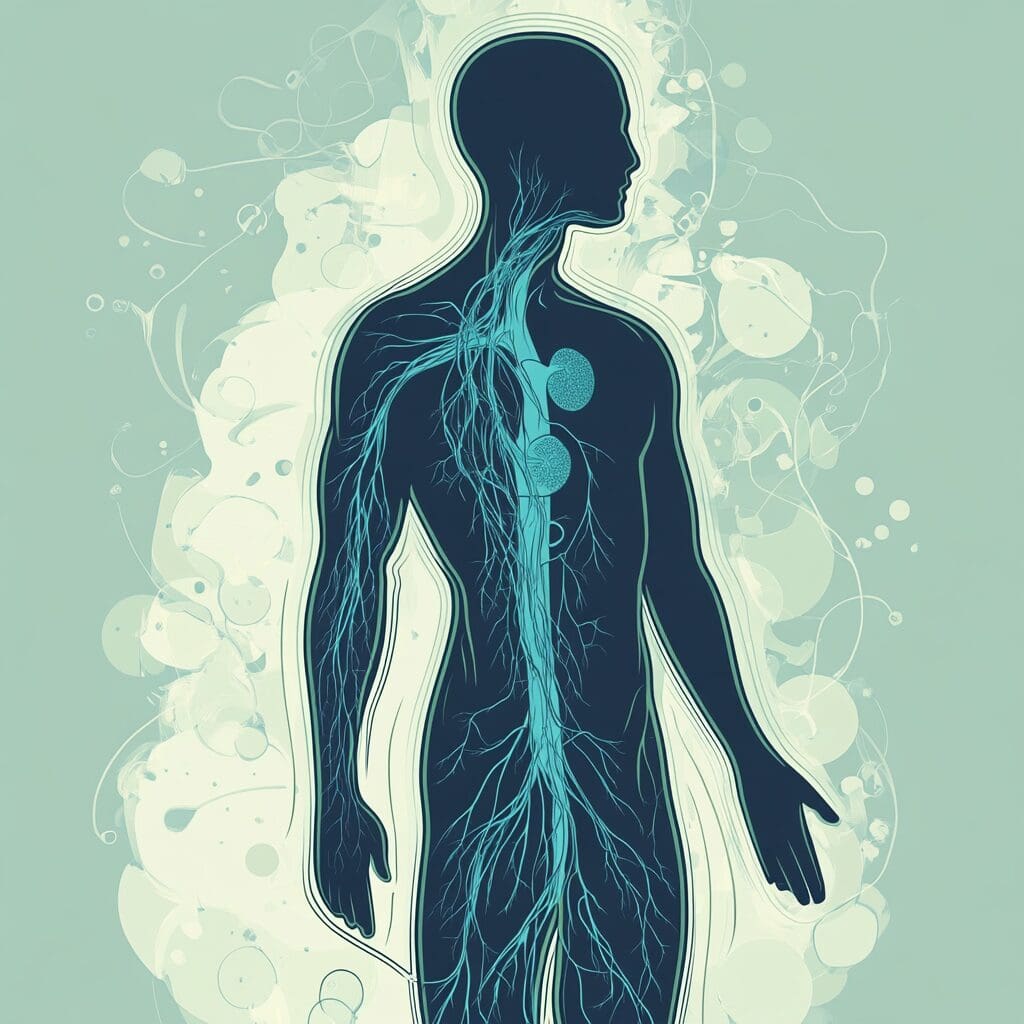What is Manual Lymphatic Drainage (MLD)?
Manual Lymphatic Drainage (MLD) is a gentle and specialized massage technique that can effectively help individuals suffering from lymphedema, edema, post-surgical recovery, and certain types of cancer.
With a focus on enhancing lymphatic circulation and alleviating swelling, MLD offers several benefits that can improve the overall well-being and quality of life of those affected. In this article, we’ll dive into the details of MLD and how it can help manage lymphedema symptoms.
Understanding Manual Lymphatic Drainage: A Comprehensive Overview
Manual Lymphatic Drainage (MLD) is a specialized and gentle massage technique that targets the lymphatic system to stimulate the flow of lymph fluid throughout the body.
Developed in the early 20th century by Danish practitioners Dr. Emil Vodder and his wife Estrid Vodder, MLD has become integral to lymphedema management and holistic health practices.
The Lymphatic System: A Crucial Component of the Immune System
The lymphatic system is an essential part of the immune system, consisting of lymph vessels, lymph nodes, and various lymphatic organs.
Its primary functions include transporting lymph fluid, which contains white blood cells and other immune cells, throughout the body to maintain proper fluid balance and support the immune system’s ability to fight infections and remove waste products.
Lymphedema and Impaired Lymphatic Function
Lymphedema is characterized by the accumulation of lymph fluid in the body’s tissues, leading to swelling and discomfort.
This can occur due to congenital abnormalities, damage to the lymphatic system from injury or surgery, or as a side effect of specific cancer treatments such as radiation therapy or lymph node removal.
When the lymphatic system is compromised, the body’s ability to maintain proper fluid balance and fight infections is significantly impacted.
The Technique: Gentle Pressure and Rhythmic Movements
MLD involves applying light pressure and performing slow, rhythmic movements to stimulate the flow of lymph fluid through the lymphatic system.
The MLD therapist will use specific techniques, such as effleurage (gliding strokes), petrissage (kneading), and tapping, to encourage the opening of lymphatic vessels and enhance lymphatic flow. This process helps to eliminate waste products, reduce swelling, and improve immune system function.
The Importance of Skilled Practitioners
To ensure the effectiveness of MLD, it is crucial to receive treatment from a qualified and experienced MLD practitioner.
Therapists specializing in MLD have undergone extensive training in the anatomy and physiology of the lymphatic system and the proper application of MLD techniques. A certified therapist will tailor the treatment to your needs, ensuring optimal results and a safe, comfortable experience.
Complementary Approaches for Comprehensive Lymphedema Management
While MLD is a valuable tool in managing lymphedema, it is often most effective when combined with other therapies and practices.
This may include wearing compression garments, exercising regularly, and maintaining proper skin care to reduce the risk of infections. By incorporating a holistic approach to lymphedema management, individuals can experience more significant improvements in their symptoms and overall well-being.
From Cancer Research UK
The Importance of Lymphatic Circulation
The lymphatic system is a vital part of the immune system, responsible for filtering and eliminating waste products, bacteria, and other harmful substances.
When lymphatic circulation is compromised, as in the case of lymphedema, the body’s ability to fight infections and maintain overall health is significantly impacted. MLD can effectively improve lymphatic circulation, relieving symptoms and promoting overall well-being.
Symptoms of Lymphedema:
Lymphedema can manifest with various symptoms, including:
- Swelling, usually in the arms or legs.
- A sensation of heaviness or tightness in the affected limb.
- Reduced range of motion in the affected limb.
- Aching or discomfort in the affected limb.
- Hardening and thickening of the skin in the affected area.
- Frequent infections in the affected limb.
- Pitting edema, characterized by skin indentations or folds when pressed.
In severe cases, fibrosis may develop, leading to the formation of hard, fluid-filled lumps beneath the skin.

The Benefits of Manual Lymphatic Drainage
By targeting the lymphatic system and promoting lymph flow, MLD offers several benefits for those suffering from lymphedema:
Reduced swelling and discomfort:
MLD can help alleviate swelling and pain in the affected limb by encouraging lymph flow.
Improved range of motion:
MLD can decrease fibrosis and enhance the overall appearance of the affected limb, increasing the range of motion.
Boosted immune system:
MLD aids in circulating lymph and immune cells, contributing to a stronger immune system and improved overall health.
Enhanced appearance of the affected limb:
MLD can address fibrosis and swelling, improving the overall aesthetic of the affected limb.
Improved mental and emotional well-being:
The relief of pain and discomfort through MLD can lead to an enhanced sense of mental and emotional wellness.
Increased physical function:
With reduced swelling and improved range of motion, MLD can enhance the overall function of the affected limb, enabling patients to engage in daily activities.
Choosing The Right Practitioner
When seeking MLD treatment, choosing a qualified and experienced practitioner knowledgeable about the lymphatic system and lymphedema management is essential.
A certified therapist will tailor the treatment to your needs, ensuring optimal results and improved quality of life.

Manual Lymphatic Drainage (MLD) FAQ's
Q1. Is Manual Lymphatic Drainage suitable for everyone?
A1. While MLD is generally safe and beneficial for most individuals, there are certain conditions where MLD may be contraindicated or require caution.
These include acute infections, congestive heart failure, blood clots, and kidney problems.
Always consult a healthcare professional before undergoing MLD to ensure it’s appropriate for your needs.
Q2. How often should I receive Manual Lymphatic Drainage treatments?
A2. The frequency of MLD treatments depends on the severity of your condition and your therapist’s recommendations.
For acute conditions, initially, more frequent sessions (e.g., daily or several times per week) may be necessary. For chronic or maintenance purposes, treatments may be spaced further apart (e.g., weekly or biweekly).
Q3. How long does a Manual Lymphatic Drainage session typically last?
A3. The duration of an MLD session can vary depending on the patient’s needs and the extent of the areas being treated.
Generally, sessions can last anywhere from 45 minutes to 90 minutes.
Q4. Can Manual Lymphatic Drainage be combined with other therapies?
A4. Yes, MLD can often be combined with other therapies to enhance treatment outcomes. For example, MLD may be integrated with compression therapy, exercise programs, and skin care regimens as part of a comprehensive lymphedema management plan.
Always consult your healthcare professional and MLD therapist about developing a personalized treatment plan that addresses your needs.
Q5. Will I see immediate results after an MLD treatment?
A5. The results of MLD treatments can vary from person to person.
Some individuals may experience immediate relief from swelling and discomfort after just one session, while others may require multiple sessions before noticing significant improvements.
Maintaining open communication with your MLD therapist and following their recommendations is important to achieve the best possible outcome.
Resources:
- Canadian Lymphedema Framework. (n.d.). About Lymphedema.
- Breast Cancer Society of Canada. (n.d.). Lymphedema
- Lymphedema Association of Ontario. (n.d.). Understanding Lymphedema.
- McKenzie, D. C. (2011). Abreast in a boat—A race against breast cancer. The Canadian Medical Association Journal, 183(10), 1151. doi: 10.1503/cmaj.110505

